| These
buildings are “replacement Cities” by Jane
Jacob's [link] definition [rbtfBook]. |
| They
impose a small footprint upon the landscape and allow
population density and open, natural, evolving
animal-populated habitats. |
| The
idea of this 1974 concept is to minimize the impact
on the landscape while creating for the inhabitants
a circumstance that allowed them to live IN Nature.
All you have to do is go down the vertical transportation
and step outside. On the raised platform, there are
gardens, parks and recreation facilities. These are
commingled and can be on more than on level. Below
this human focused landscape is parking, mass transportation
access and infrastructure. Beyond this raised
platform is “natural” landscape. Most likely, this
will be in rings ranging from more “domestic” and
progressing to pure “wilderness.” There will also
be numerous parks and landscape areas in the upper
regions
of
the superstructure. In fact it will be encrusted
with living matter. It is critical not to interpret
these sketches, and the mega-city concept, as one
would “read” a drawing of a building as
we know know it. These forms are massive - they are
VOLUMES - and are to
be understood to be superstructures with
imbedded infrastructure
that creates a series of external facing and internal
facing multistory spaces that can be “developed”
as a city
word normally grow
and
change
over time. The superstructure is just human-made
“land.” |
|
| Mega
cities can be built in ecologically sensitive areas
- which are often the most beautiful and subsequently
ruined by improper development and over use. The
concrete base connecting these three structures
were conceived to balance each other by turning static
vertical
loads and dynamic wind loads into tension (counteracted
by post tensioning) by the parabola forms that connected
them. In the “cup” created in the center
of these structures, organized human activity would
take place.
Parking is below. On the outside of these parabola
forms, landscaping is introduced. Other than this,
the beach with its natural, shifting beach-building
processes is left in a natural state. Access is kept
to a level that the beach can self-repair and sustain.
This
way a substantial population can enjoy the amenity
while not destroying it. Projects like these can
be spaced some distance apart while matching the
population density of the “peanut butter spread” strategy
of traditional beach development which is destructive
to the host environment and vulnerable
to destruction by common weather occurrences which
are misnamed as “tragedies” with equally misidentified
“victims.” Of course, this requires an entirely
new approach to
real estate
development
and zoning [link]. |
| Structures
like these can be manufactured and built to withstand
flooding and hurricane force winds. It is always
interesting to me that my car can drive through rain
and winds
that would destroy my conventional built house and
that we routinely fly airplanes through storms that
routinely destroy cities. One wonders that sometime
someone might start wondering about this. |
|
| These
cities can be built of super modules. The helix form
shown here is composed of three modules, linked together
into super-modules with an assembly rule that
can be applied in a right hand or left hand mode.
This offers a beautiful “dna” helix form creating
a high variety of exterior exposures to view, wind,
sun and multiple different “interior atrium” volumes.
The
horizontal and vertical intersections create
a great number of different kinds of
spaces. Complexity generated from simplicity. This
kind of structure can be built of prefabricated units
of several scales of recursion - “super bricks” for
fast site assembly. |
| What
cannot be shown with drawings and models of this
scale is the landscaping and zoning algorithms. The
model that people hold in their head is that of the
massive monolithic concrete apartment building with
long halls of artificial light. This is a poor model.
Think of the super-structure as Armature [link] and
Infrastructure [link] and
think of this - as a whole [link] -
as a human built mountains where humans, animals
and plants can live on and
within [link].
The open space default rule will be much like was
employed in the Boulder Affordable
housing design [link]. |
note:
the links provided above do not give literal examples;
you have to generalize from them and be aware that
the same ideas are being illustrated at different
size/scale
recursion levels and in different contexts. |
| Paolo
Soleri’s Arcologies [link] illustrate
these potentials
brilliantly. The design of his that I most want to
see executed is Hexahedron, an Arcology for 100,000.
It is one of his earliest designs and one that is
eminently build-able. |
|
|
Go
to Thesis Criticism
Paolo
Soleri Hexahedron |
|
|
|
|
Wilderness
MegaCity - 1976 |
| Wilderness
megacity is designed to be built in extreemly remote
areas. It is accessible only by walking of my mono-rail.
the scale can be appreciated when you realize that
the “stalagmite” structures hanging down
from the bowl-like form are, themselves, 20 to 30
story buildings.
It is also important to realize that you will never
see the structure as it is drawn. Its entire skin
is a metabolic strategy that changes from reflecting
to translucent to transparent to open based on a
complex “breathing” strategy that is “controlled”
by both users and an algorithm for optimum heating
and cooling. |
| The
cities themselves can have a focus and draw an affinity
population to them around a variety of principles:
scientific, political, religious, economic, recreational,
lifestyle, goods production, “experiences” and
so on. This is how cities in the past were developed.
Today, they just seem to grow with no rhyme or reason
- most modern cities lack focus, they have no theme.
They are simply the consequence of population expansion
and economic exploitation with some planning and
better development thrown in now and then.
This is not how the great cities of the past were
created. With the exception
of a few core city areas, the US citizen has to
go to Europe to discover what a city really can be. |
| Negative
impacts on the Earth must be minimized at the building
site, as well as, to the larger landscape that surrounds
the development. The amount of open “natural” landscape
in relationship to the scale and scope of the building
- and the impact of its use - must be “scaled ” as
is appropriate, by the capability of the landscape
to sustain itself and the project. |
| I
first started thinking about the issue of urban sprawl
and land coverage by Human construction (if it can
be called that) in 1956 with my San Francisco Apartment
Building project [link]. At that time, I was
concerned how the Bay Area had been developed since
I first
experienced it 10 years before. What has happened
since the mid 50s, I will not comment on here. |
| Wilderness
Mega City was conceived as a “health” retreat
center of those displaced by rapid change or disasters
- or simply for those who want to recuperate and “retool.” The “practitioners” of
these services - from health to learning - would
live in the City as residents. Guests would come
and pay a daily rate to live there for some period
of time with some surcharges for specific professional
help. The population ratios would be about one third
providing general living support services, one third
specialize health and learning services and one third
guests. These numbers work out quite well. The typical
capital represented by a successful professional’s
home, office and infrastructure contribution in a
typical city multiplied by the number of working
professional in this health center will capitalize
this project.
Cities are capital intensive; they are best built
over time.
This is true for mega-cities, however, they can be
less capital intensive per capita given
that an artifact of this sort can be far more economical
and efficient than traditional development strategies.
It is important that they still be “built” as
a traditional city is built: evolving over time.
The difference
is that the Armature-Infrastructure-Structure is
designed to accommodate this growth and evolution
and that a predetermined density is known from the
beginning. This “density” equation pertains
to the ratio of city to open landscape, to the various
zones
within the mega-structure, to public space and individual
spaces and the layout of individual working and living
units. Far more density per acre yet far more individual
space and amenity can be achieved in the mega-city
than with traditional schemas. This is the consequence
of employing VOLUMN. All the Pattern Language
values that Alexander [rdtfBook] has
identified can be achieved in the mega-city - it
is a matter of design and following the principles
of The Timeless Way of Building. |
| All
of the economic principles that can be designed-in
on the Domicile [link] scale
work even better (to a point) with these Mega City
concepts. |
| Cites
should be dense. This is what makes them “hot” fun
and productive. The fact that they are crowded, dirty
and almost impossible to get around in, most of the
time, and have obliterated the landscape (that originally
attracted) is not intrinsic to the density - it is
the result of the wrong conceptual frame and poor
design. This is the natural consequence of the process
by which we make them - and employ them - or overuse
them to be exact. |
| The
mega-city concept does not challenge nor replace
the role of the traditional city. There is still
an important place for this artifact in our history,
culture and economy. It is just that the traditional
city schema can be pushed only so far in terms of
horizontal growth. It is a scale issue. In fact,
the patterns of the Medieval city still make
some of the finest city habitats on the planet. Add
modern technology, limit the use of the car, provide
well designed mass transportation and rejuvenate
the landscape that once was there in Medieval times
(the crowding came later), and the “core” city
comes to life as we have seen with numerous examples
where this has been done in Europe. Mumford has a
point on this subject [link].
There is a reason that Frank
Lloyd Wright’s year in Italy circa 1910-11 had such
a profound impact on his work that followed (a point
often overlooked in the “scandal” of it all). |
| In
turn, Mega-Structures do not have to loose human
scale and overwhelm all sensitivity to the natural
setting - again, bad design rules the day (of our
existing sprawling, undisciplined “mega-cities” and
with many of the apartment buildings on steroids
masquerading as mega-city proposals). The construction
process, itself, does not have to
destroy the site. These is no sense to what we do
and it is not economical [link]. |
| A
warning is in order. Any kind of city can
impose tremendous negative consequences on the landscape,
indigenous
peoples, animals and , ultimately, on the planet
itself [rbtfBook].
Today, we have no way to deal
with these consequences because our organizational
structures exist on one
level but are creating negative conditions on a “higher”
level at which no governance structure exists. A
traditional approach to “government” at
this global level would
be a disaster beyond measure. Not putting
a process in place, however, will ultimately destroy
the diversity
of life on a scale that is almost incomprehensible
- and unforgivable. A better approach is required [link]. |
|
| The
Xanadu project [link],
predates these Mega city concepts - in architectural
concept - but was not put on paper until 2000 [link].
It is on a somewhat smaller scale than the others
(Wilderness Mega City is nearly three times taller
and much greater in volume) but employs the same
kind of design strategy. The range of population
that can be appropriately served
using
these architectural
strategies and configurations is somewhere between
1,000 and 100,000 (and even much more) in a single
structure. It should be remembered that downtown
Manhattan is
several
million people in a single structure. |
| With
these concepts certain principles predominate: Small
foot print surrounded by minimally obstructed, “natural” landscape.
Vertical and horizontal transportation schemes that
promote fast access. A three dimensional view point
rather that the “flatland” architecture
of today (we do not build multi-story buildings,
we build one story building stacked on top of one
another). A wide variety of architectural space types
accomplished with a
relatively
simple
and modular
geometry. “Mass” automated transportation
to the Mega city for larger structures; self-contained
parking for the smaller ones - minimal use of landscape
for transportation in either case. Maximum use of
off site prefabrication to minimize on site disruption.
Mixed use. A greatly enhanced ability to design and
manage the nuances of different kinds of human interactions
and their attendant support mechanisms. |
| A
Mega city is a scaling up of what MG Taylor has been
doing with NavCenters and knOwhere Stores and Disney
Corporation has been doing with Theme Parks: Designing,
building and operating integrated environments that
are finely tuned to support specific human processes.
Traditional cities do not allow this degree of refinement. |
| Most
of what is negative about traditional cities can
be eliminated: crowding, too much resource dedicated
to transportation, the unnecessary impact of weather,
the covering of the Earth and crowding out of other
species, pollution, and a schema that allows and
encourages endless growth. |
| Much
of what is wonderful about traditional cities can
be kept: neighborhoods and open spaces, organic development,
individualized building, urban interaction, population
diversity, unique character and expression on the
meta level of the city itself. |
| Most
people, of course, think a Mega city is a large apartment
building scaled up. This certainly does not have
to be the case. The typical apartment building cannot
be justified as a human habitat let alone thinking
it can be scaled. A Mega structure can have orders
of magnitude more variety and actual space per individual
than traditional solutions because they make use
of three-dimensional space - they are not “flat.” |
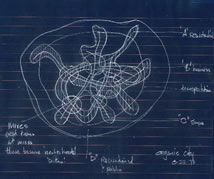 |
| This
layout makes full use of “ribbon streets” (each
a zone) and NODE organization (each
a hub of several zones crossing, creating an
urban “hot spot” and connecting
vertically to others [link]. |
|
| The
Armature [link] of
the Mega city is it’s basic structure and service
components. All the rest of the structure can be
built over time, replaced, changed, evolved individualized. |
| Many
feel that Mega cities (as a concept) are inhuman
in their size. This is a non issue. Is a village
of 5,000 inhuman per se? What about a city of 20,000?
Or, 100,000? These are considered small, today. The
issues is not the size, it is scale - and design.
In fact we build Mega Cities today, they are just
poorly
designed.
The important scale issue is that of human scale.
One reason that traditional cities try to spread
out is only horizontal space is considered as “space.” One
reason that large buildings seem crowded is because
they are designed that way for reasons of false economy.
Imagine the cost of roads and spread out utilities
and what kinds of amenity even a fraction of this
wasted money could bring to a Mega structure if properly
employed. More individual space and access, in less
overall space, is possible in a Mega structure for
the same reason MG Taylor/AI can get more
knowledge workers in less space [link] with
more individual work space and sense of space. It
is in the configuration schema. |
| The
ideas intrinsic to the megacity concept are highly
applicable, as noted, on recursion levels smaller
and larger. DOMICILE is an example of a
multi-family scale co-housing project that employs
many of the
same design strategies and economic principles. Xanadu is
larger and far more diverse than Domicile yet
still an order of magnitude smaller that a true megacity.
Most of my megacity concepts have been on the modest
scale of the size range mostly because my focus has
been on concepts that may be build-able in the near
term (if you can call 50 years, near term); I have
Charted a series of projects from house size, EcoSphere - each an order of magnitude greater than its predecessor
- to Domicile, Crystal Cave, Xanadu,
megacities to space colonies. The idea being that
the lessons
in structure, mechanics, fabrication processes, building,
financing; and, social structures, governance and
economics learned on one recursion level will promote
the effort
for the next. This is the notion of systematic R&D
and prototyping to accomplish an otherwise too complex
future goal. Megacities cannot be done from nothing
to mature state all at once, yet, they do not evolve
out of the traditional city. A strategy is
required if you are serious about doing it. |
| In
time, we will be “forced” [link] to
do mega-cities. The questions are: will be be ready?
Will we do it
well
or poorly? Will the mega-city of the future be the
already over extended traditional city [link]?
This is the result we will have if we approach this
issue by “not thinking about it.” |
|
| A city of 100 thousand is proposed for Siberia, designed by Russian architects Ab Elise, to be build 1,804 below ground in an abandoned mine with a glass roof. A good use - assuming health issues can be dealt with - of a consequence of the industrial era. A good response to the Siberian climate. |
|
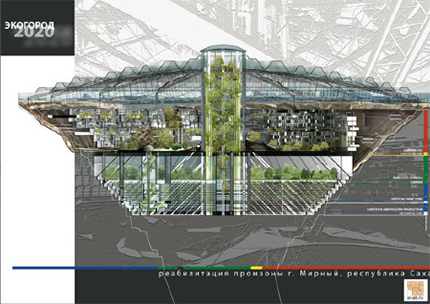
| Good Magazine reports: “ ...if it's actually built, it could serve as an object lesson in designing cities for the future's potentially volatile climate.” |
| I find this project encouraging. The design looks to be conceived well, it deals with a scar in the ground and makes a great deal of ecological sense. The primary design issue that there may be risk of ignoring is that of the cultural and governance aspects. the time has come for mega cities however the issues of ecology that Soleri raised long ago and the the social-economic issues that I raised in the 70s have not been addressed by a progression of “doubling” projects as I have proposed starting with Domicile scale projects. |
click on graphis and logo for more information |
|
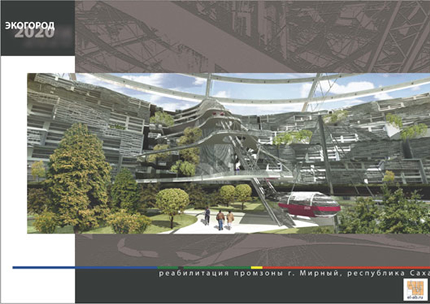
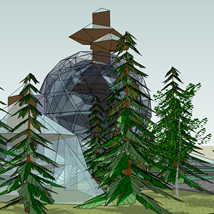 |
Domicile One is a co-housing project designed to increase the standard of living of it’s occupants while radically cutting costs and ecological footprint. It is also a step in a series of “self-contained” environments with, if doubled each iteration, can provide real world experience with the many technical, biological and human systems necessary to the successful making of a mega-city.
The question is not if we can make designs like what is profiled here work well. Not doubt we can. The question is if we have the time to take the time to do it. |
|
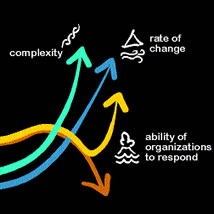 |
| Robert Heinlein said “that when it is time to railroad, people will build railroads.” This is true and is certainly time to mega-city. The caution is that large scale projects, designed as a single piece and build all at once tend to fail. Cities that evolve increment by increment over a long period of time tend to be more human and full of amenity. They also tend to ultimately paint themselves into a corner. What we are dealing with here is the delicate balance between intent and spontaneity; between design and emergence. Learning how to do this well is one of the greatest challenges before Humanity at this moment of global transformation. |
|
|
| Space Colonies - the L5 Inteview |
|
|
|
|
| Domicile
One - CoHousing Alternative |
|
|
|
| Domicile
One Design Development |
|
|
|
|
| Boulder
Affordable Housing Project |
|
|
|
|
| Architectural
Projects 1952 - 2004 |
|
|
|
|
Matt
Taylor
Palo Alto
February 21, 1999

SolutionBox
voice of this document:
VISION • STRATEGY • SCHEMATIC
|
|
posted
February 21, 1999
revised
December 11, 2004
• 20000201.133045.mt • 20000629.161512.mt •
• 20010303.987245.mt • 20041028.661234.mt •
• 20041029.333300.mt • 20041311.635132.mt •
•20101120.810433,my • 20041311.635132.mt •
• 20120128.812443.mt •
(note:
this document is about 60% finished)
Copyright© 1973
1974, 1976, 1999, 2000, 2001, 2004, 2010, 2011, 1012 Matt Taylor
IP
Statement and Policy |
|
|

